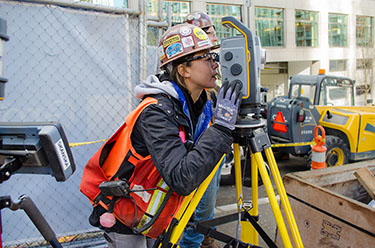|
Subscribe / Renew |
|
|
Contact Us |
|
| ► Subscribe to our Free Weekly Newsletter | |
| home | Welcome, sign in or click here to subscribe. | login |
Construction
| |
 |
March 8, 2018
Inclusiveness: We've taken steps, but have only started the journey
Skanska

McGillie
|
Women in Construction Week highlights how far our industry has come in the past decade. I'm proud to work for a company where women serve in roles ranging from account managers to laborers. It's not the construction industry of a generation ago, for sure.
Still, as I work to make my company the construction firm of choice for women in Seattle, I ask, how can we do more to make sure our entire construction industry offers fun and dynamic careers? Do people want their daughters to pursue a construction career? Women and people of color are still underrepresented in our industry. When you consider the labor shortage that affects the local construction market's overall capacity, the need to attract new and diverse people is underscored. We all must commit ourselves to several actions so we can change our industry for the future, together.
Internal networking support
For starters, we need to accept that office cultures in many industries have not always been welcoming for women and people of color. I remember a story one of our account managers told of not being invited on a fishing trip with her male team members that served as something of an unofficial team building event. This was a case of the organizers simply thinking she wouldn't be interested in fishing (spoiler: she loves to fish).
When women are left out of softer networking opportunities like that, though, it can affect the relationships they build and, more urgently, it reinforces an environment where women are separate.
Our Skanska Women's Network helps bring those issues to the fore. Through meaningful programming and well-organized local chapter leadership, we've built an inclusive way for these topics to be addressed. I've watched it change the way we work and, while we have a long way to go, it's interesting to see how long-tenured employees are being more thoughtful about the culture they create.
Our local chapter has also influenced the way our office works in a number of ways, not the least of which is a rotation of employees through our leadership meetings so they can be part of building a culture of inclusive decision making. Other industries have had these sorts of internal networking groups for a long time. It's time for all of us in construction to follow suit.
Research also shows that diverse candidates want to look around and see themselves reflected in their leadership. In environments where that is not yet reality, one of the only ways to move the needle for those employees is active sponsorship (not just mentorship) by someone already in a management role.
All of this supports the business imperative of inclusion. More inclusive teams make more informed business decisions, resulting in better business results, which attract even more diverse people and points of view. We believe that being the best construction and development firm directly correlates to being the most inclusive, diverse construction and development firm. The employees we want to recruit expect this.
Recruiting … and retaining
Our industry needs to change the way we recruit employees. While our efforts to recruit talented college graduates will continue, we have to remember that construction offers people without a degree a very well-paying career path.
The labor shortage in the market shows what happens when our industry does not attract enough new workers to the trades. We need to work with high schools — and even middle schools — to engage students. Programs like the ACE Mentor Program are in place to push people toward careers as project managers. We need to put an equal amount of support into apprenticeship programs.
Given the cost of college, construction can be an attractive employer.
That said, we won't keep people if the culture they come into doesn't meet their needs. I believe there's a misconception that young people don't want to work as much. If anything, I've found younger employees starting in our company to be ready to work hard and learn. What they want is to be treated with dignity and the peace of mind to know that they can go to the doctor or handle something at home in the morning and catch up on work later in the day.
We are examining ways we can increase flexibility. With laptops, mobile technology and more, we have the tools we need. Longer term, we have to find ways to make sure flexibility applies beyond telework. For example, does it make sense to have a talented team member only work part time for a period, or share a job with a coworker? I'd rather find a way to be flexible than lose a great person.
Supporting the industry
Inclusivity cannot be just the job of a few firms. As much as we compete for talent and seek to establish our own cultures, we need to support our entire industry becoming more diverse.
We have programs in place to help show traditionally underutilized small businesses how they can win work and grow. Most small and certified-disadvantaged businesses don't have the back office support that larger firms take for granted. When we help a women-owned subcontractor succeed, it fills in a new piece of the inclusion puzzle, creating new possibilities for employees and future entrepreneurs.
Beyond these steps, we need to show how fulfilling and fun work in construction can be. We see the wonder on children's faces when they see the big equipment or tall cranes around our city. How do we keep that spirit alive and use it to attract people?
I think it comes from sharing the stories of what we do, going beyond the amazing things we build to show how we do it safely. Or how the work actually supports the community. Or how the work contributes to the sustainability of our region. We're often too comfortable behind the jobsite fence or too humble about what we achieve.
We're making progress, but it would be a shame if we let the momentum that progress has created slip. Together, we can continue to change the perception of our industry and the faces of the people who make it.
Anita McGillie is senior human resources manager at Skanska.
Other Stories:
- WSDOT wants to tweak DBE program to get more African Americans firms
- WIC Week elevates women's role in construction industry
- Mentors are crucial in a tough industry



